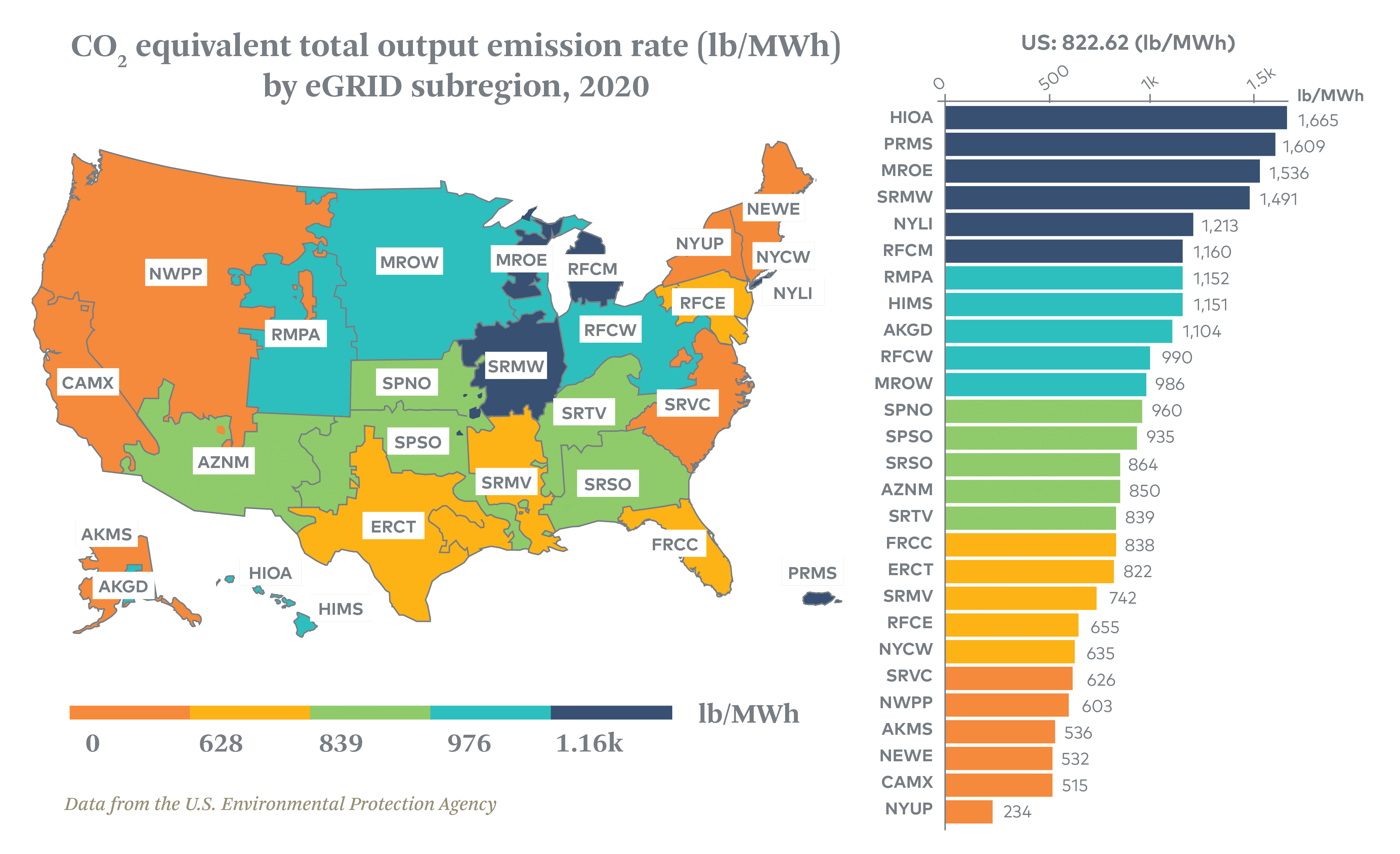When organizations embark on a new renewable energy procurement, specifically a power purchase agreement (PPA), they often have several criteria that they are trying to satisfy with the new project. With the climate crisis becoming critically urgent, many of 3Degrees’ clients are prioritizing carbon displacement value as one of these decision making criteria. Put simply, more buyers are interested in ensuring that their renewable energy project has the largest climate benefit possible – which is good news!
In this three-part blog series, Maximizing Carbon Displacement with PPAs, we will dig into strategies that organizations can use to evaluate PPAs for decarbonization impact. To kick off the series, we start with one strategy that is fairly straightforward: choosing your market.
Carbon intensity in the U.S. grid
Some buyers have a very specific market in mind for their procurement, such as one that maximizes potential hedge value, projected financial value, etc. However, they may not be aware of how that market compares in supporting their desire to maximize the project’s carbon displacement value – meaning the amount of carbon emissions that are actually being “pushed off” the electric grid by the renewable energy from the new project.
Most people are aware that some regions of the country – and the world – rely more heavily on polluting energy sources to power their electric grid so, naturally, a project located in one of these higher carbon intensity regions will have a larger carbon displacement benefit than one located in an area that already has a lot of renewable energy generation capacity. In the U.S., this example can be brought to life if you look at the Great Plains states that are relatively coal dependent, which results in a higher carbon intensity compared to Texas, for example, the national leader in wind energy production (19.5% energy generation from wind in 2020). So, a project located in North Dakota would have a significantly higher carbon displacement value than a project in Texas, which means our clients may decide to execute renewable energy PPAs for projects in North Dakota instead of Texas.
One important note as it relates to a renewable energy project’s geographic location and the example above: the Greenhouse Gas (GHG) Protocol, used widely for carbon accounting, does not distinguish between a project located in a higher carbon intensity market and a lower one for the purposes of carbon reporting; a renewable megawatt hour (MWh) is a MWh, regardless of its location. So in a company’s GHG inventory, a project in North Dakota is not going to look any different than a project in Texas. Customers can certainly feel better knowing their project has a more significant impact if it’s located in a higher carbon intensity region, but it’s not going to show up any differently in their carbon accounting.
Carbon intensity, and why time of day matters
Clients are often curious how carbon intensity in a grid is calculated. There are different methodologies used to calculate a market’s carbon intensity that all relate to how the emissions factors in a grid are calculated. Two of the most common factors are average emissions and marginal emissions.

Data from U.S. Environmental Protection Agency. Average emissions rates in the U.S. based on grid regions. The northwest and northeast are dominated by hydro, while nuclear leads in the southeast, coal is the primary in the rust belt and mountain west, while the south is led by natural gas.
The average emissions method looks at all power plants operating in a given market and the associated emissions generated during a certain time in that region, and divides them by the amount of electricity produced during that same time period.
To calculate carbon intensity using the marginal emissions method, you only need the emission factor of the marginal power plant in the generation stack for a given market – the rest of the power plants operating do not factor into this calculation.
The marginal emissions calculation is intended to take into consideration which resource was last added into the generation mix and, therefore, would be the marginal plant displaced if additional renewable energy assets were added to that grid. Both methods can illustrate why time of day matters for carbon intensity, but the marginal power plant calculation is more influenced by this component and, therefore, renewable energy technology as well as regional power plant operation trends. For example, wind generation peaks at night, a time of low energy usage, which means most generation is coming from base load plants. Therefore, a wind PPA executed in a state with strong nuclear base load energy will have a lower carbon displacement value than a wind PPA in a state with more base load coal generation. This is because the wind power would be displacing the low emissions coming from nuclear plants vs. higher emission coal plants. However, a solar PPA in this same state may have a high carbon displacement value because the facility would be generating electricity during hours that natural gas peaking plants are online to meet peak demand.
To recap: when deciding where to procure a renewable energy PPA, it’s worth closely considering the market – and how specific renewable technologies will intersect with that market – in order to ensure maximum “carbon displacement bang for the buck.”
Up next: Carbon arbitrage
In the next blog in this series, we’ll take a look at how alternative technologies can play a role in carbon arbitrage. In the meantime, if you have any questions about your company’s renewable energy procurement strategy and would like support with it, please reach out to us.


